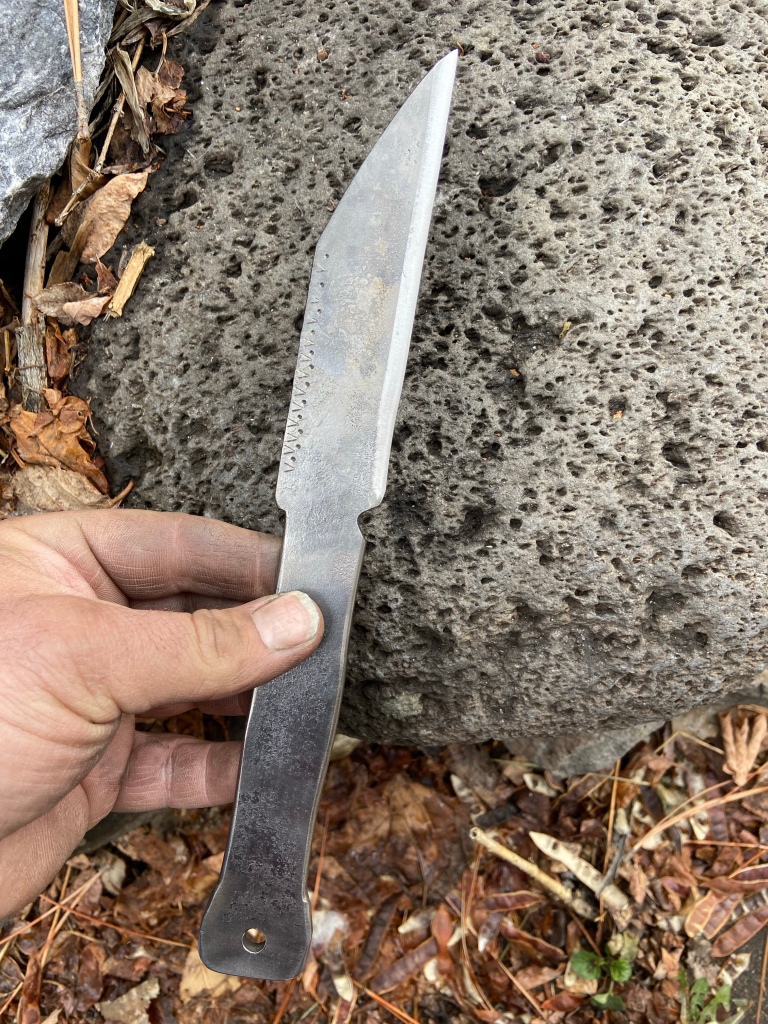Anglo Saxon word of þe dæg:Glēd
Anglo Saxon word of þe dæg:
ᚪᚾᚷᛣᚩ ᛋᚪᛉᚩᚾ ᚹᚩᚱᛞ ᚩᚠ ᚦᛖ ᛞᚫᚷ᛫
Glēd (ember,Fire, Live coal, Ash, spark, Flame) akin to shine, gleam, glow. From Proto Germanic “glōdiz”(glow/heat). ᚷᛚᛖᛞ᛫
Also: Fȳr (fire)
Example:
Iċ ēode þurh þæt fȳr and ne barn.
I walked through the fire and did not burn.
————
Þēah þe hit ċeald wǣre, ne ǣlde hē þæt fȳr.
Though it was cold, he didn’t light the fire.
—————
Þǣr þǣr smīec biþ, þǣr biþ fȳr.
Where there’s smoke, there’s fire.
——————
Compare:
West Germanic: *glōdi
Old English: glēd
Middle English: glede, gleede
Scots: gleed
English: gleed
Old Frisian: glōd, glēd
Saterland Frisian: Gloud
West Frisian: gloed
Old Saxon: glōd (in compounds: glōdpanna, glōdwelo, etc.)
Middle Low German: glōt
Low German: gloot
Plautdietsch: Gloot
Old Dutch: *gluod
Middle Dutch: gloet
Dutch: gloed
Limburgish: glood
Old High German: gluot
Middle High German: gluot
German: Glut
(Luxembourgish: Glous) (secondary influence)
Old Norse: glóð, *glœð
Icelandic: glóð
Faroese: glóð
Norwegian: glød
Old Swedish: glø̄þ
Swedish: glöd
Old Danish: glø̄th
Danish: glød
Scots: glude
—————-
Bonus:
īs (ice) from Proto Germanic “Isa”. ᛁᛋ᛫
īsiġ (Icey)
īsċeald (ice cold) 
Ic earmcearig iscealdne sæ winter wunade.
In winter I lived, wretched, on the ice-cold sea.
Compare:
West Germanic: *īs
Old English: īs
Middle English: is, ise, yes, yce, yys, ys, ijs, yse, ysz, hyse, hyys, ice, isse, ysse, yis
English: ice
Scots: ice
Old Frisian: īs
North Frisian: Iis, Is, is
Saterland Frisian: Ies
West Frisian: iis
Old Saxon: īs
Middle Low German: îs
German Low German: Ies
Plautdietsch: Iess
Old Dutch: *īs
Middle Dutch: ijs
Dutch: ijs
Limburgish: ies
Old High German: īs
Middle High German: īs
Alemannic German: Iis, Is, Isch
Alsatian: Iis; Eis (northern)
Italian Walser: isch, éisch
Bavarian: ais
Cimbrian: ais
Central Franconian: Eis, Ies
Luxembourgish: Äis
German: Eis
Frankfurt: [ais]
Pennsylvania German: Eis
Vilamovian: ajs
Old Norse: íss (< *īsaz)
Icelandic: ís
Faroese: ísur
Norwegian: is
Old Swedish: īs
Swedish: is
Danish: is
Elfdalian: ais
Gutnish: eis, h’eis
——————
Hroðberht-
Anglo Saxon word of þē dæġ : Seaxe
Anglo Saxon word of þē dæġ:
ᚪᚾᚷᛚᚩ ᛋᚪᛉᚩᚾ ᚹᚩᚱᛞ ᚩᚠ ᚦᛖ ᛞᚫᚷ᛫
Seaxe (Saxon “A Saxon”) from the root “Seax” meaning a certain type of knife carried by Germanic people.
ᛋᚪᛉᚩᚾ᛫
_____________________
Bonus: Rún (mystery/secret) “rune” an alphabet and divination system used by ancient Germanic cultures.
ᚱᚢᚾ᛫
……………………………………………………


Norse Seax and its finer points of design.
The Norse Seax:
Length 7 to 24 inches historically.
Date of invention early: Iron age.
Meterial: Iron/Steel.
Notabe details: Steep drop angle nose and straight cutting edge.
Name: Seax is from the Germanic word “SAX” meaning short sword or long knife.
NORSE: Sax
ANGLO SAXON: Seax
……………………………………………………..
The Saxon people derived there name from this weapon because of there lengedary use of the weapon. No man was without this blade in the time of migrations. The popularity of the blade was so woven into Nordic culture that the Seax in style existed from the early iron age through the Viking age.
The Norse/Saxon warrior often carried:
1 Spear
1 Seax
1 Sword
1 belt knife
A hand Axe could also be added to this already fully stocked personal armoury.
H-
A Spring Wind Blows in the North of Every Mans Heart.
And so it was destiny to bend steel to my will-Prologue:
Late winter began to release its frozen claws from the land and the clean fresh air bristled across the still yellow grasses in the foothills. All kind of small green beings had begun the journey to life in the small spaces between the rocks. East I stood far from the shelter of the great mountain near my home but as I stood on the crest of great rolling hills and gazed across mighty stone laden mountains I could see distantly the mountains I call home. Green with fur, pine and snow still laying upon its highest granite monuments. This day was not the day I first laid a hammer to glowing steel but it was the day I forged what was to be the first blade that revealed like a great epiphany that my destiny was to bend iron to my will and with this revelation all manner of wisdom, knowledge, instinct, natural spirit and understanding would be laid before me to take. With every strike of my hammer, careful choice of antler, engraving of ancient sacred symbols this blade took form and came to life, revealing what was possible and that the idea of limits no longer existed.This is not a hobby for me or a source of income. It is destiny and an expression of my beliefs, culture and heritage to share with any and all who care to see what I create. I love art in all forms and appreciate art that truly means something. I am proud to be a part of the new American Art/Artisan, Hand crafted movement. I am a dedicated “Green” artist and I take pride in recycling everything I can to make my art and I will recycle as much as I can as long as the end product does not suffer in quality. Being green also means seeing potential in commonly available resources and not wasting material that has been purchased for projects. No usable steel, copper, wood or antler is wasted. 90% of all antler used is collected by hand in my very own mountains with no harm coming to the environment or herds of deer. The other 10% was acquired from various sources where it would have sat and gone to waste otherwise. Green means sustainable sources, no environmental harm and a working relationship with nature as a part of nature.

Forþryne !
Hröðebert-







